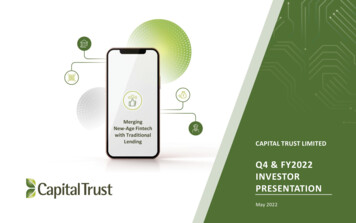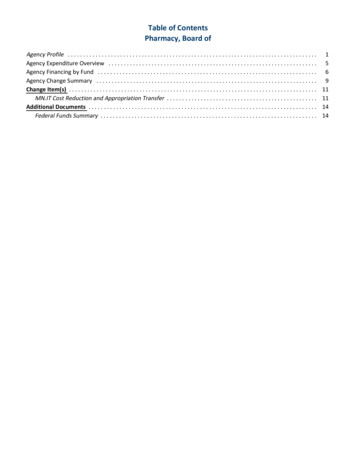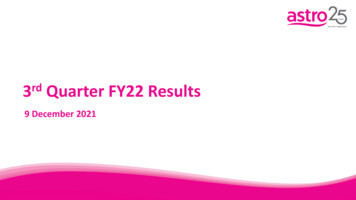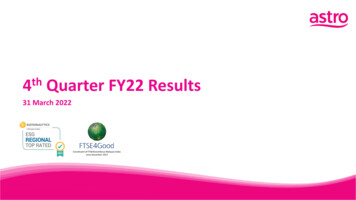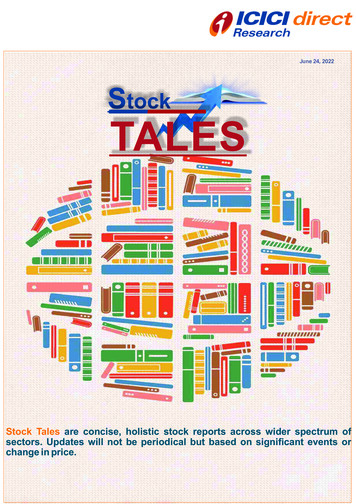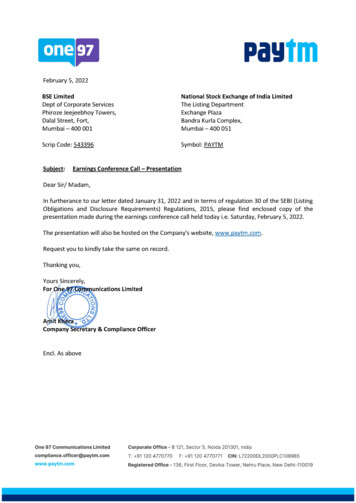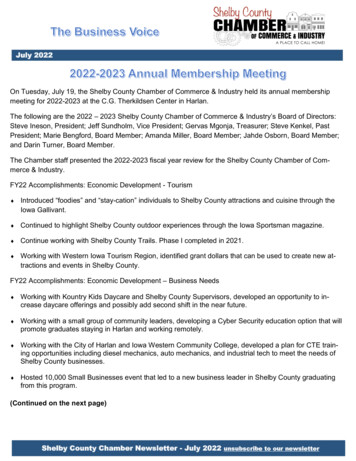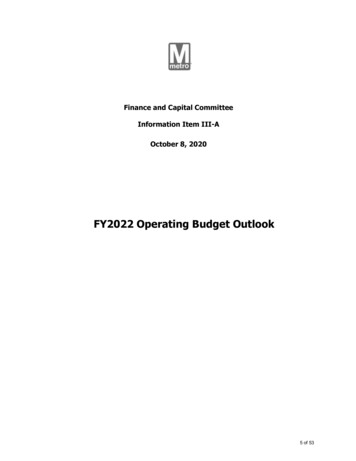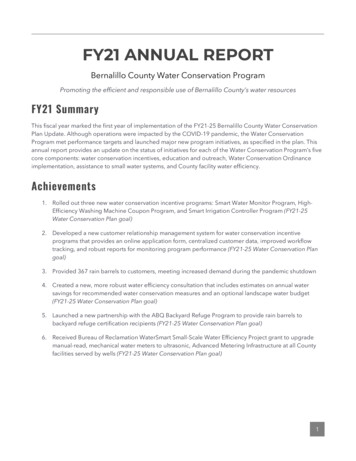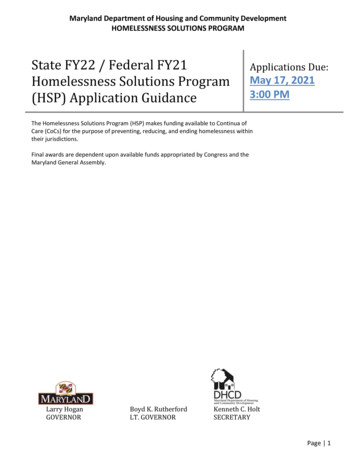
Transcription
Maryland Department of Housing and Community DevelopmentHOMELESSNESS SOLUTIONS PROGRAMState FY22 / Federal FY21Homelessness Solutions Program(HSP) Application GuidanceApplications Due:May 17, 20213:00 PMThe Homelessness Solutions Program (HSP) makes funding available to Continua ofCare (CoCs) for the purpose of preventing, reducing, and ending homelessness withintheir jurisdictions.Final awards are dependent upon available funds appropriated by Congress and theMaryland General Assembly.Larry HoganGOVERNORBoyd K. RutherfordLT. GOVERNORKenneth C. HoltSECRETARYPage 1
OverviewThe Maryland Department of Housing and Community Development (DHCD), Division of NeighborhoodRevitalization, administers the Homelessness Solutions Program (HSP). HSP brings a number of differentfunding sources in order to provide one consolidated stream of funding for local Continua of Care (CoCs) toaddress homelessness.The Department estimates that approximately 10.4 million will be available in State and Federal funding,dependent on funds appropriated by Congress and the Maryland General Assembly.HSP funds are made available in order to assist households experiencing homelessness to be connected withemergency shelter, quickly regain stability in permanent housing and to prevent households from becominghomeless. The goals of the program include efforts to:oooooProvide shelter as a crisis response for people experiencing homelessness;Reduce the number of individuals/households who become homeless;Shorten the length of time an individual or household is homeless;Reduce the number of individuals/households that return to homelessness; andProvide fixed or short-term rental assistance payments to people at risk of being homeless.Additional Funding - 1 million for Youth Experiencing HomelessnessServing homeless youth and unaccompanied homeless youth continues to be a priority policy area for DHCD.To that end, Governor Larry Hogan has provided 1 million in additional funding to support programs thataddress youth homelessness in Maryland. In anticipation of the adoption of the Governor’s Budget, theDepartment will make 1 million available for programs that serve youth experiencing or at risk ofhomelessness. These funds will be largely aligned with the Ending Youth Homelessness Act of 2018 (EYHA).Expected Funding Availability for State Fiscal Year 2020 (Federal Fiscal Year 2019)(Subject to legislative approval)NameEmergency SolutionsGrant (FFY2020)State HSP Funds(SFY2021)Youth HomelessnessFundsSourceAmountFederal - HUD 1,169,121Maryland 8,439,261Maryland 1,000,000TOTAL 10,440,058Funds will be allocated annually, with each annual grant administered over a 18-month grant period (July 1,2020 – December 31, 2021). The funding may support efforts to: (1) rapidly re-house homeless individualsand families; (2) engage unsheltered homeless individuals and families; (3) provide emergency shelter forhomeless individuals and families, including operations and essential services for residents; (4) preventfamilies and individuals from becoming homeless; and (5) track information about services provided througha Homeless Management Information Systems (HMIS) database.Grantee EligibilityPage 2
Maryland Department of Housing and Community DevelopmentHOMELESSNESS SOLUTIONS PROGRAMFunds are available to eligible Continua of Care (CoCs) within the State of Maryland.Grantees must comply with program guidelines and applicable state and federal policies and procedures,including compliance with federal and state non-discrimination laws.Application Deadline and FormatApplications are due to the Maryland Department of Housing and Community Development by 3:00 p.m.on May 17, 2021. All applications must be submitted through the CDS Project Portal.Page 3
APPLICANT REQUIREMENTS – HOMELESSNESS SOLUTIONS PROGRAM (HSP)Eligible ApplicantsApplicants must be the Lead Agency, or Collaborative Applicant, of a Continuum of Care (CoC).Eligible ActivitiesHSP provides funding for five main activities:1) Housing Stabilization Services. Housing Stabilization Services are designed to help people locate,pay for, and remain in permanent housing. Eligible costs include rental assistance, financialassistance, and case management. Housing Stabilization Services are also separated by the type ofclient being served: Rapid Re-Housing (RRH) covers services to individuals and households that are“literally homeless,” meeting the HUD category 1 definition of homelessness. HomelessnessPrevention (HP) is for households who do not meet the category 1 criteria, but are still consideredat-risk of homelessness. DHCD prioritizes Rapid Re-Housing as an intervention that focuses on thosemost in need of services, but recognizes that both RRH and HP are necessary strategies foraddressing homelessness.2) Emergency Shelter. Emergency Shelter covers activities that connect people with immediate accessto overnight shelter in order to respond to a crisis. Funding provided for Emergency Shelter can beused both to pay for the operations of the shelter, such as rent and utilities, as well as servicesprovided by the shelter, including case management. Please note that any shelter that acceptschildren is considered a “Family” shelter, and therefore must accept all families, regardless of thesex, sexual orientation, gender identity, or age of any members of the family. “Women andchildren shelters” are not eligible for funding through HSP.3) Outreach. Outreach is for services that are provided to currently unsheltered individuals andfamilies, including engagement and case management. This also covers the Homeless Resource Dayevents that are intended to connect people with available services, and activities designed tosupport the annual Point-in-Time (PIT) count.4) Permanent Supportive Housing Case Management. Permanent Supportive Housing CaseManagement services include linking residents to supportive services such as job training, healthcare, budgeting counseling, parenting skills, substance treatment, etc, as well as staff costs for thosewho assist clients in applying for food, medical, and other benefits.5) Homeless Management Information System (HMIS). HMIS funding helps cover the costs of datacollection through an HMIS database. Costs in this category are capped at 10,000 per Continuumof Care. All providers must be entering data into HMIS or, for victim services providers, acomparable database.CoCs are strongly encouraged to utilize data and demographic information to determine the needs ofcommunities and to apply for funds accordingly.Page 4
Maryland Department of Housing and Community DevelopmentHOMELESSNESS SOLUTIONS PROGRAMPage 5
SubgranteesCoC Lead Agencies may subgrant all or part or their entire grant amounts to government agencies ornonprofit organizations to provide HSP and YH-eligible services. Subgrantees must demonstratecollaboration with local homeless provider groups and local mainstream service providers. Subgrantees areexpected to participate in Continuum of Care planning appropriate to the jurisdiction where their HSP or YHactivities are located.CoCs that are awarded HSP or YH funding are required to perform due diligence in regards to organizationalcapacity of subgrantees before making awards. Funding decisions for subgrantee agencies should be basedon an objective process and review of the agency’s programs, including the following factors:1. Effectiveness in connecting clients who are most in need of services with shelter and permanenthousing;2. Past performance on federal- and state-administered grants;3. Organizational structure, operating process, and capacity;4. Participation in appropriate provider groups and local Continuum of Care meetings;5. Organizational financial policy, controls, stability, and capacity, including the presence and accuracyof financial management systems, accounts, funds, reports, and other documentation.CoCs will be required to perform financial and programmatic monitoring on subgrantees and ensure thatprograms are operating within the requirements and regulations of the program. On-site monitoringshould be conducted at least once during the grant cycle.Matching FundsAll CoCs must provide matching funds of at least 25% of the amount requested. This match requirementmay be met at the community and/or grantee level, allowing communities to use programs or servicesfunded by local and private resources as a match for this funding. The amount and source of any matchingfunds or services must be clearly stated in the match budget of the application submitted.In order to meet the match requirement:1) Matching contributions must be used to meet the HSP goals: reducing the number of people whobecome homeless, shortening the length of time people are homeless, and reducing the number ofpeople who return to homelessness.2) Matching funds must be received and expended within the HSP grant year contract period (July 1,2021 – December 31, 2022).3) Contributions cannot be used to meet multiple match requirements. This includes using match froma previous HSP grant - matching funds can only be counted in one year.4) Matching contributions may be obtained from any local or private source. No federal sources maybe used, except funding provided by the Community Services Block Grant (CSBG) for the purpose ofmeeting HSP goals. Additionally, no state sources may be used, except funding provided throughthe Emergency Assistance Program (EAP), formerly known as the Homelessness PreventionProgram. For federal and state sources, the grantee must ensure the laws governing any funds usedas matching contributions do not prohibit those funds from being used to match HSP funds.Page 6
Maryland Department of Housing and Community DevelopmentHOMELESSNESS SOLUTIONS PROGRAMAdditionally, if HSP funds are used to satisfy the matching requirements of another federal program,funding from that program may not be used to satisfy the matching requirements of HSP.Matching funds may include the following:1) Cash contributions. Cash expended for allowable costs of the grantee/sub-grantee.2) Non-cash contributions. The value of any real property, equipment, goods or services contributedby the community / grantee towards meeting the HSP goals.Administrative FundsCoCs are eligible to apply for up to 10% of the grant request in administrative funding. Administrative costsare those costs which are used for the purpose of managing the grant (e.g., preparing the application,financial reporting, program monitoring, training) and do not include program staff costs. The LeadAgency may retain all funding requested for administrative costs, or may subgrant that funding to anyagencies that are involved in carrying out those functions.Data CollectionApplicants must enroll in the Homeless Management Information System (HMIS) (or a comparabledatabase for victim services providers) of their Continuum of Care to be eligible for HSP funds.Grantees/subgrantees must be in compliance with all requirements set forth by HUD and by the local HMISlead agency with the exception of victim services providers.All activities funded under HSP must comply with HUD’s standards on participation, data collection, andreporting under a local HMIS (including those victim service providers using a comparable database). Allcurrent or previously funded HS grantees/subgrantees are required to be in full compliance with HMISimplementation guidelines at the time of application. New HSP subgrantees must be in full compliance withHMIS implementation at the time a grant agreement is signed.Victim service providers are not required to participate in the local HMIS due to confidentiality and safetyconcerns, but are required to establish a comparable database approved by the HMIS lead agency of theContinuum of Care. Victim services/domestic violence providers must document how they intend to ensurethat HSP reporting policies and procedures are in place and followed while ensuring the confidentiality ofparticipants.Applicants must also be participating in the Maryland State Homelessness Data Warehouse (MSHDW). TheData Warehouse uses information from HMIS to provide program reporting, and as such, all grantees areexpected to be providing information that meets all data quality standards. Failure to do so can result in areduction of funding awarded.Page 7
APPLICANT REQUIREMENTS – YOUTH HOMELESSNESS (YH) FUNDINGAssuming adoption of the funding levels in the Governor’s FY22 Budget now under discussion in the MarylandGeneral Assembly, the Department is planning to award a minimum of 1 million dollars in FY2021 HSP funding toproviders working with unaccompanied youth and young adults experiencing homelessness or at risk ofhomelessness. The Department intends to deploy these funds largely in alignment with the Ending YouthHomelessness Act of 2018.Eligible ApplicantsApplicants must be the Lead Agency, or Collaborative Applicant, of a Continuum of Care (CoC).Eligible Population to Receive Services“Unaccompanied homeless youth” is defined as follows:An individual of 24 years of age or younger who is not in the physical custody of a parent or guardian and lacks afixed, regular, and adequate nighttime residence who:- Lives in a supervised publicly or privately operated shelter designated to provide temporary livingarrangements.- Lives in a motel, hotel, or campground due to lack of alternative adequate accommodations.- Shares the housing of other individuals due to loss of housing, economic hardship, or similar reason.- Lives in a transitional housing program or other time-limited housing.- Has a primary nighttime residence which is a public or private place not designed or ordinarily used as aregular sleeping accommodations for individuals, such as a car, a park, an abandoned building, a bus or trainstation, or an airport.“Youth at risk of homelessness” is defined as follows:An individual 24 years of age or younger whose status or circumstances indicate a significant danger of experiencinghomelessness in the near future, and:- Is exiting a publicly funded institution or system of care.- Whose primary caregivers are currently homeless or have previously been homeless.- Who experiences serious or sustained conflict with the individual’s caregivers that is likely to result in familyseparation.Eligible ActivitiesYouth Homelessness Funding will fund the following activities for individuals up to the age of 24 who lack afixed, regular, and adequate nighttime residence, or who are at risk of homelessness:1) Street and community-based outreach to youth. Funding awarded will cover services that are provided tocurrently unsheltered youth individuals and youth headed families, including engagement and casemanagement. Some portion of the budget request may be dedicated to costs associated with participating inthe bi-annual Youth REACH MD count.2) Drop-in programs, funding will cover costs associated with day programs, which should be consideredseparate from youth emergency shelter programs. Funding can be used towards operating costs andoperations of the day/drop-in program, including case management.Page 8
Maryland Department of Housing and Community DevelopmentHOMELESSNESS SOLUTIONS PROGRAM3) Emergency Shelter for youth covers activities that connect youth with immediate access to overnight shelterin order to respond to a crisis. Funding provided for Emergency Shelter for youth can be used both to pay forthe operations of the shelter, such as rent and utilities, as well as services provided by the shelter, includingcase management. This funding can cover individual youth and/or families with a head of household memberbetween the ages of 18 up to 25.4) Rental Assistance, short (up to 3 months) or medium-term (up to 24 months) of rental assistance to youththat are placed into permanent housing from being unsheltered, from transitional housing, or fromemergency shelter.5) Case management funding will fund staff hours of case management services that support youth placed in orwho are already living in permanent housing, to ensure they remain housed.Page 9
APPLICATION OUTLINE AND INSTRUCTIONSMaryland DHCD will only accept one application per Continuum of Care. Each CoC should fill out all of theinformation required in the application. The CoC is responsible for compiling funding requests fromselected subgrantees and coordinating to ensure that the total funding request matches the amount offunding available. The CoC will use the Project Portal application budget section in order to ensure thatrequests align with the amount of funding available and all other requirements.CoC’s will primarily use the Project Portal to submit the application, and will submit the grant narrative as adocument in their Project Portal application. Training in how to use the Project Portal to submit theapplication and support documents will be provided as part of application training, and a link to thewebinar and slides will be made available to grantees for reference. Project managers will also be availableto provide assistance and answer questions as needed.Maryland DHCD will only accept one application per Continuum of Care. Each CoC should fill out all of theinformation required in the application. The CoC is responsible for compiling funding requests fromselected subgrantees and coordinating to ensure that the total funding request matches the amount offunding available. The CoC will use the provided budget application sheet in Excel in order to ensure thatrequests align with the amount of funding available and all other requirements.In addition, each CoC must certify that their subgrantees meet the HSP requirements, and that they willperform at least one risk assessment of all grantees over the term of the grant period, and a monitoringand compliance visit to all grantees considered high risk, and several subgrantees selected based on riskassessment criteria.While individual providers will be evaluated based on performance measure and similar factors, inclusion inthe HSP application and requested funding amounts are solely the responsibility of the local Continuum ofCare.If the Continua of Care Lead Agency is a nonprofit organization, it should also attach the followingdocuments to the application in the Project Portal:1.2.3.4.5.6.Articles of Incorporation and BylawsFederal Tax Exemption Determination LetterCertificate of Good StandingList of Board of DirectorsAgency Organizational ChartMost Recent A-133 or Independent Financial Audit7. W-9 FormPage 10
Maryland Department of Housing and Community DevelopmentHOMELESSNESS SOLUTIONS PROGRAMEVALUATION OF APPLICATIONSAll Continuum of Care applications will be subject to two reviews:1) A threshold review, ensuring that the application is complete and that all program requirementshave been satisfied.2) A competitive review of the Youth Application to determine the capacity of the selected providersfor implementing the goals of the Ending Youth Homelessness Act Program.Level funding will be awarded to the Continuum of Care, provided that it passes the threshold review.Competitive funding for youth programs will be awarded on the basis of the youth application and FY20and FY21 program performance.Page 11
GENERAL INFORMATION2022 Homelessness Solutions Program Application TimelineApril 1, 2021 – Application will be emailed to CoC leads and available for download thereafter from theDHCD websiteApril 7, 2021 - Application live on Project PortalApril 8 – Training session from 2-3:30PM Webex (training will be recorded)May 17, 2021 – Due date for application and all related materialsJune 2021 – Notification of awardsJuly 1, 2021 – Grant period beginsPage 12
client being served: Rapid Re-Housing (RRH) covers services to individuals and households that are "literally homeless," meeting the HUD category 1 definition of homelessness. Homelessness Prevention (HP) is for households who do not meet the category 1 criteria, but are still considered at-risk of homelessness.

